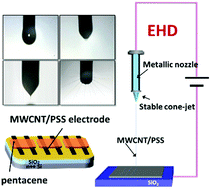Direct patterning of conductive carbon nanotube/polystyrene sulfonate composites via electrohydrodynamic jet printing for use in organic field-effect transistors†
Abstract
Carbon-based conductive lines were directly patterned using an electrohydrodynamic (EHD) jet printing technique. We successfully dispersed multiwalled carbon nanotubes (MWCNTs) in a polar solvent through a size-sorting and blending process involving polystyrene sulfonate (PSS), and we fabricated a homogeneous MWCNT/PSS nano-composite ink for EHD printing. We demonstrated that EHD printing was affected by the type of solvent, which adjusted the surface tension of the MWCNT/PSS ink. Ethanol, with a lower surface tension compared to water, provided four different jetting modes, depending on the applied voltage and working distance. EHD-printed MWCNT/PSS conductive lines were used as source/drain (S/D) electrodes in organic field-effect transistors (OFETs). The resulting OFETs showed reliable performance with negligible hysteresis on chlorosilane-terminated polystyrene (PS-brush)-modified substrates.


 Please wait while we load your content...
Please wait while we load your content...